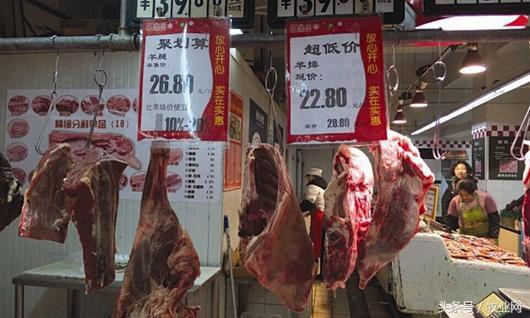Why the price of mutton continues to fall and has hit bottom? Analysis of Mutton Price in 2017
In previous years, as the weather turned cold in autumn and winter, mutton sales also ushered in the peak season. However, mutton prices in many places remained low at the national market in 2016. This year is not only the most extraordinary year for sheep farmers, but also the most volatile year for mutton sheep prices. The price of mutton continues to fall, making some sheep farmers complain incessantly; for our consumers, the lower price is good for consumption. But this also greatly affects the enthusiasm of farmers, so that the development of mutton sheep breeding industry is volatile, in the long run, it is not a good thing for consumers.
Why is the price of mutton still low? So is the price of mutton at rock bottom?
Why is the price of mutton falling? Reviewing the price of mutton, we can find that there is no doubt that the price of mutton has reached a new high from 2013 to 2014, but from 2014, the price of mutton began to decline gradually. This decline has continued until 2016.

According to the market data: in November 2013, the price of mutton in Beijing Yuegezhuang is 52 yuan / kg, the price of mutton in Inner Mongolia Chifeng Xicheng is 56 yuan / kg, and the price of Wuerhe mutton is 65 yuan / kg. According to the price market in November shown by the national agricultural product business information public service platform, the price of mutton in Beijing Xinfadi Agricultural products Wholesale Market is 33.3 yuan / kg, and the price of mutton in Xicheng City, Chifeng, Inner Mongolia is 44 yuan / kg. In November this year, the price of Wuerhe mutton is 42 yuan / kg.
It is widely believed that the small ruminant epidemic that occurred in the first half of 2014 was the trigger for the decline in mutton prices in 2014. In order to control and eliminate the epidemic situation, the relevant departments have strengthened the supervision of the transportation of live sheep and strictly prohibited the transfer of live sheep from high-risk areas to low-risk areas, resulting in the pressure of live sheep in the main producing areas. After the eradication of the epidemic, sheep under pressure were concentrated on the market, the supply of mutton surged in a short period of time, and prices fell.
However, the epidemic is only an inducement to the fall in mutton prices. In fact, it is due to the weakness of market consumption, the decline of residents' consumption level and the lack of purchasing power.
First of all, under the influence of slow macroeconomic growth, urban residents' purchasing power of mutton is declining; at the same time, high-end consumption is also declining, residents' consumption of mutton and roast lamb is significantly reduced, and the demand for mutton in the recession of the catering industry is also decreasing. Another important factor is that the price of mutton has continued to rise since 2000, the price is on the high side, the purchasing power of residents is insufficient, and the low price of pork and chicken increases the substitution of mutton consumption. this has led to a decline in consumer groups.
In the golden period when the price of mutton continues to rise, the number of mutton sheep is also increasing. According to statistics, China produced 4.28 million tons of mutton in 2014. At the same time, the amount of mutton imported is also increasing rapidly. The amount of mutton imported into China was about 66000 tons in 2009 and reached 120000 tons in 2012, while the amount of mutton imported rose to about 250000 tons in 2013.
While supply exceeds demand, the demand for mutton is reduced due to the influence of the domestic economic environment. The price of mutton falls as supply continues to increase while demand continues to decline.
The slump in the mutton market in recent years has made it not only difficult for sheep farmers to make money, but many of them even lose money. An 8-month-old lamb costs more than 500 yuan. Due to the dry climate in our country this year, even the flocks of sheep need extra forage for our farmers, and the price of forage has been rising in recent years. For many sheep farmers, the investment outweighs the return. To raise sheep is to lose money, raise more and pay more.
Is the price of mutton at a low ebb? will it fall again? Perhaps this is what the majority of sheep farmers are most concerned about at the moment. Throughout the current situation of the mutton sheep market, the current price may have reached a trough. As the price of mutton has been falling for nearly three years, the price of mutton has hit bottom, and then the price will pick up somewhat, but it is unlikely to return to a very high price in the past two years.
- Prev

It is necessary to reflect on the fact that raising Loach does not make money this year.
It is necessary to reflect on the fact that raising Loach does not make money this year.
- Next

There is a great demand for African chrysanthemum with an annual net income of 20,000 yuan per mu.
There is a great demand for African chrysanthemum with an annual net income of 20,000 yuan per mu.
Related
- A course of planting techniques and methods on how to grow carrots
- How to plant the latest tulips?
- Is it better to pick tea in the morning or in the afternoon? When is the best time for tea to be picked? what is the third or fifth tea?
- Launch Yuanxiao Happy combination Haocha + Tea Yuan healthy Taste
- Penghu Tourism "Fireworks 20 Parade with You"
- 2022 West Lake Happiness holds "Digital Revitalization Voucher" and draws iphone13 and laptop.
- Banqiao Fuzhou social houses are designed to change start-up combined with police elimination to create a safe and livable environment
- The convenient measure of "mechanical weeding" in Xinbei has been abused and the Agriculture Bureau has imposed heavy penalties on the illegal land consolidation.
- Changgeng University Joins Hands with Four Memory Factories to Rescue Memory Talent Shortage
- The list of Taiwan's top 100 MVP managers is listed by the Director-General of the Farmers' Association of Sanxia District.

